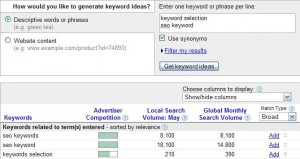 So, you now are full steam ahead on your blog, that’s great. What’s next? Well, if you are trying to drive traffic to your site and have not yet jumped into the fray that is Search Engine Optimization (SEO), then you need to start reading up.
So, you now are full steam ahead on your blog, that’s great. What’s next? Well, if you are trying to drive traffic to your site and have not yet jumped into the fray that is Search Engine Optimization (SEO), then you need to start reading up.
Educational SEO Resources
There are a lot of sources of information on Search Engine Optimization (SEO) out there and I don’t presume to know all of the best ones, but I do know some very good sites for learning more about Search Engine Optimization. The first is Wordtracker, with Wordtracker Academy being their primary section for educational information on the subject of SEO keywording.
A couple of other good sites for finding more SEO topic coverage include SEOmoz and HubSpot. If you would like to get some WordPress specific SEO information, check out the Yoast website by master WordPress plugin author Joost De Valk.
Tools and Methods for Selecting Keywords
So, how does one research keywords? Well, one free tool is Google’s Adwords Keyword Tool. It will generate statistics around the keywords you provide as well as provide related keywords that may be applicable too. Information is provided on the number of searches the keyword is specified in for a given month (on Google) and the advertiser competition for those keywords.
Another tool available for selecting keywords is that provided by Wordtracker. This service is a subscription service but trials are available so you can get a feel for its utility.
What else is there? Well, if you can’t think of just the right words people may use to search on, you can use Microsoft Word’s thesaurus to locate other words related to those you can think of. Then maybe run those through Google’s Adwords Keyword Tool.
You also can do some Google searches that you think would be applicable for your content and review some of the pages that pop-up on the front page of the search engine results. Look to see what their content contains as well as how they titled the page and what they specified for the meta description and the page’s URL. Meta data values can be found by viewing the source of the web page. Typically this menu item is located under the “View” menu and will be named something like “View Source” or “Page Source”. Look for the title, meta description and meta keyword entries. While search engines don’t use the “keywords” meta data anymore, many sites may have populated it and it will contain words they were targeting.
So, now you have the keywords you feel you should use, what do you do with them? Well, without diluting your message, incorporate these words into your post’s title, content and meta description. Pay particular attention to any headings and anchor text (i.e., links) as they help identify important words to search engine spiders.
Selecting the right keywords is really an acquired skill that one develops over time. It does add more time and effort to pulling together your post but is important for driving traffic your way. Just remember, though, don’t get to myopic and forget your message. It is still critical that the content you are providing is interesting, informative and helpful as generating inbound traffic still relies a lot on good old word-of-mouth and other sites linking to your site. You want to bring your visitors back for more and also have them bring you to the attention of their social network by generating links back to your Posts, so, quality is point one.
